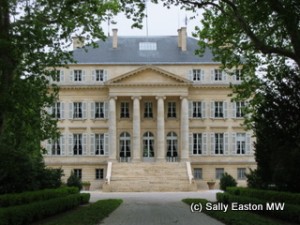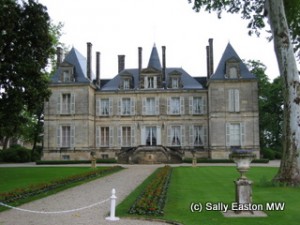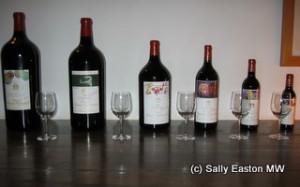Bordeaux and cabernet sauvignon
A version of this article first appeared in Australia’s Winestate magazine, in 2008.
Cabernet sauvignon is the most renowned grape variety in the world, the veritable king of grapes. It’s homeland and the apogee of its expression, invariably blended with a little merlot, has always, undeniably, indisputably been held to be on the left bank of the Bordeaux region, in France. Bordeaux’s right bank, in the notable appellations of Saint Emilion and Saint Emilion Grand Cru, focuses more on a blend of merlot and cabernet franc.
It was in 1855, when left bank châteaux were classified as part of the Paris Exposition of the same year. Merchants took as their framework the price lists for the previous years and drew up a list of some 60-plus châteaux which were consistently getting the highest prices on the Bordeaux Place, the trading hub for Bordeaux wines. Bordeaux has never looked back.

Château Margaux
At least, Bordeaux’s upper echelons. Looking at the trading prices for the 2005s (in 2008) – Château Lafite-Rothschild was £9,200 a case (AUD$19,080).
But Bordeaux is not a singular place, and when a Bordeaux château-owner tells you Bordeaux is like a whole country, it pricks up your attention to reality check the statement. With 123,000 hectares of vineyard in the Bordeaux appellation, that’s more than Chile, it’s more than South Africa, it’s more than Germany. Up until a few years ago, it was more than Australia. And this also reveals the fundamental dichotomy that is Bordeaux. The top end is aspirational and sublime. The bottom end often struggles to be sold.
One of cabernet sauvignon’s assets is that it maintains good varietal definition and flavour under reasonably different production and climatic regimes. It’s a vigorous vine, it grows easily in a variety of different soils. Though ‘hot’ climate cabernet sauvignon does become distinctly different, taking on baked, jammy, hot attributes which overwhelm the normal varietal character, such as cassis, blackcurrant, cedar notes with French oak.
cabernet sauvignon is now planted the world over
Because of its adaptability, and because any and all wine-producing regions have wanted to emulate the top, top wine producing region in the world, cabernet sauvignon is now planted the world over. France has 59,000 ha, half of which is in Bordeaux; Australia has as much cabernet sauvignon as Bordeaux; California has 30,000 ha, Chile has 40,000ha.
In the face of all this ‘extra’ cabernet sauvignon out there, is the bottom end suffering from new world competition? If top end Bordeaux is about 3% of Bordeaux’s production, the bottom end is about 50% of the region’s production – about 3 million hectolitres, or one-quarter the total production of Australia.
Michael Cox, the UK director of Wines of Chile, the promotional agency for Chilean wines, said “cabernet sauvignon was taken to Chile in the 1850s and has thrived. One of reasons for Chile’s success in the 80s and 90s was because the style of cabernet sauvignon was a pure expression of ripe, vibrant fruit and soft tannins.” It’s a rare (increasingly less so), warm vintage in Bordeaux that the fruit can make that particular claim. He added “the difference between top, top quality Chilean cabernet sauvignon and average quality Chilean cabernet sauvignon is relatively narrow. But in Bordeaux the difference is huge.” The difference in Bordeaux is split by a chasm.

Château Pichon Longueville Comtesse de Lalande
A general measure of ‘success’ for everyday Bordeaux is the price of a tonneau. This is the traditional measurement of 900 litres (or 4 barriques of 225 litres each) by which quotidian wine is traded. When the price is up around the €1,000 mark (AUD$1,638), as it was in 2008, Bordeaux tends to be reasonably happy. Back at the end of 2005, the tonneau price was about €750 (AUD1.36/litre), barely enough to live on. As a comparison, Australia’s 2008 statistics showed the average export value is AUD$3.85/litre. 2005 marked a low point for everyday Bordeaux wines, the stunning quality of the vintage notwithstanding.
But Bordeaux’s, as France’s, main historic problem is a dramatically declining domestic consumption, which has halved over the course of a generation. This, plus of course, declining exports in the face of new world competition and a consumer preference for ripe, soft-fruited, soft-tannin wines.
One small trend that reflects this is a snail-like increase in plantings of merlot, by two percentage points over the last half a dozen or so years, at the expense of both cabernet sauvignon and cabernet franc. This is likely to be because merlot is (a) slightly earlier ripening than cabernet sauvignon, therefore ‘easier’ to grow in a cool, maritime climate and (b) reflecting the trend to ‘easier’ wines – merlot has lighter tannins, sweet alcoholic fruit, and the resulting wine needs less time in bottle. But the degree of change in plantings is so slight as to have no real discernible influence on the final wine style.
The latest figures from Bordeaux showed it was in recovery in 2008, before the recession really set in. Exports were starting to grow again. They were up 7% volume and 9% value to €1.38 bn (AUD2.27bn). Just as Australia looks to China, Russia and other Asian markets for more export success, so does Bordeaux. Exports to China were up 158% in 2007.

Château Mouton Rothschild
Top end Bordeaux is largely immune to the competitive market. It’s traded as a commodity these days; it might as well be lead, or copper, or concrete (or gold). If posh UK wine merchant Berry Bros. & Rudd can sell £60 million of the 2005 vintage, things are not too bad for top Bordeaux.
Changes are afoot though, in both the lower and middle sectors of the market. Mark Walford, of Bordeaux negociant Richards Walford, said: “There was a period in Bordeaux’s history, when people were making wine to please Mr. [Robert] Parker. They are finding their vineyards are more suited to an accent on finesse than attack. There are many young châteaux owners making wine in this style rather than the Californian style.”
And at the bottom, Walford continued, appellations such as “Bordeaux Supérieur are having to stand on their own feet. They need to pick grapes properly ripe, not overproduce, and raise the wine with care. I think they’re still Bordeaux in style. They don’t get the sugar levels [of the new world] especially with cabernet sauvignon. Certainly, wines have to be made better to appeal to the market” suggesting in part Australians, and other new world producers, may have passed technical lessons to Europe in how to make wine. Walford cited Domaine de Chevalier, in the Graves, where the style of winemaking is getting finer, more refined and stylish as the team there gets into their stride, implying that this is the opposite of a new world style.
If new world competitivity has done anything, it’s make Bordeaux (and arguably the rest of the old world) realise that however typical wines are of their region, they must still appeal to consumers.



